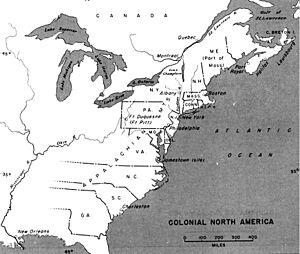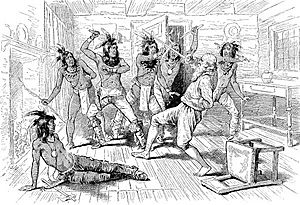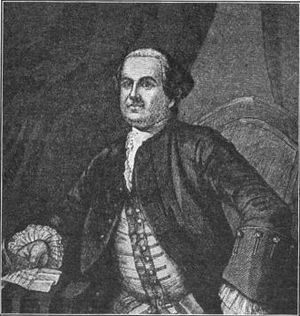King William's War facts for kids
Quick facts for kids King William's War |
|||||||
|---|---|---|---|---|---|---|---|
| Part of the Nine Years' War | |||||||
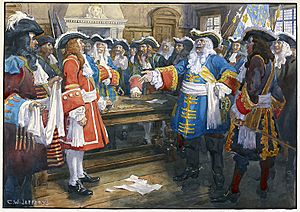 Count Frontenac, governor of New France, refused English demands to surrender prior to the Battle of Quebec. |
|||||||
|
|||||||
| Belligerents | |||||||
| Wabanaki Confederacy | Haudenosaunee | ||||||
| Commanders and leaders | |||||||
|
|
||||||
King William's War was a big conflict in North America from 1688 to 1697. It was part of a larger European war called the Nine Years' War. This war was the first of several colonial wars fought between New France (French colonies) and New England (English colonies). Both sides had their Native allies.
Neither England nor France sent many soldiers from Europe to help with the war in North America. The French and their Wabanaki Confederacy allies stopped New England from expanding into Acadia. Acadia was a French territory that included parts of present-day Maine. When the war ended in 1697 with the Peace of Ryswick, the borders between French and English lands in North America stayed mostly the same.
Contents
What Caused King William's War?
This war started because earlier peace agreements, like those after King Philip's War (1675–1678), were not followed. English settlers were also worried that Native Americans were getting help from the French or Dutch. There was a lot of distrust and confusion among all groups. The English believed the Native Americans were their subjects, but the Native Americans did not agree. These tensions led to conflicts, including King William's War.
North America in the Late 1600s
At the start of the war, there were over 154,000 English settlers. This was 12 times more than the French population. However, the English were spread out in many different colonies along the Atlantic coast. These colonies did not work well together. Also, the English were dealing with their own political problems, like the Glorious Revolution. They also lacked strong military leaders and had a difficult relationship with their Iroquois allies.
New France had about 14,000 people in 1689. It was divided into three main areas:
- Acadia along the Atlantic coast.
- Canada along the Saint Lawrence River and up to the Great Lakes.
- Louisiana from the Great Lakes down the Mississippi River to the Gulf of Mexico.
Even though the French were greatly outnumbered, they were more united. Many French men had military experience. Knowing they had fewer people, the French made good friends with the indigenous peoples. This helped them increase their fighting strength. They also used clever hit-and-run tactics in battles.
European and Colonial Tensions
The war in Europe, the Nine Years' War, began in 1688. England's Catholic King James II was removed from power in the Glorious Revolution. Protestants William III and Mary II became the new rulers. William joined a group of countries called the League of Augsburg to fight against France. King James II had fled to France.
In North America, there was a lot of tension between New France and the English colonies. The English colonies in the north had joined together in 1686 to form the Dominion of New England. New England and the Iroquois fought against New France and the Wabanaki Confederacy. The Iroquois controlled the important fur trade around the Great Lakes. They had been fighting with New France since 1680. New England encouraged the Iroquois to stop trade between New France and western Native American tribes. In response, New France attacked Seneca lands in New York. The Iroquois, with English support, then attacked New France, including a raid on Lachine.
There were also problems on the border between New England and Acadia. New France said its border was the Kennebec River in southern Maine. English settlers from Massachusetts had built towns in this area. To protect their claim to Maine, the French set up Catholic missions in three large Native American villages: Norridgewock on the Kennebec River, Penobscot on the Penobscot River, and Medoctec on the Saint John River. The five Native American tribes in Acadia formed the Wabanaki Confederacy. They allied with New France to stop the English from expanding.
Key Events of the War
Fighting in New England, Acadia, and Newfoundland
This part of the war is also known as Castin's War. In April 1688, English Governor Edmund Andros attacked Castine's home and village on Penobscot Bay. In August, the English raided the French village of Chedabouctou.
In response, Castin and the Wabanaki Confederacy attacked English settlements along the New England/Acadia border.
- On August 13, 1688, they attacked New Dartmouth (Newcastle), killing some settlers.
- A few days later, they killed two people at Yarmouth.
- In the autumn of 1688, they killed two families at Kennebunk.
The next spring, in June 1689, hundreds of Abenaki and Pennacook warriors, led by Kancamagus and Mesandowit, raided Dover, New Hampshire. They killed over 20 people and captured 29, who were sold into slavery in New France. In June, they killed four men at Saco. The English sent soldiers to find the bodies and chase the Native Americans, but they lost many men in fights.
In August 1689, Jean-Vincent d'Abbadie de Saint-Castin and Father Louis-Pierre Thury led an Abenaki group. They captured and destroyed the fort at Pemaquid. This was a big loss for the English. It pushed their frontier back to Casco (Falmouth), Maine.
New England fought back by sending Major Benjamin Church to raid Acadia. Church led four attacks into Acadia (which included most of Maine) against the Acadians and the Wabanaki Confederacy.
- On his first trip, on September 21, 1689, Church and 250 soldiers defended English settlers at Falmouth. The Wabanaki Confederacy killed 21 of his men, but Church's defense worked, and the Native Americans left.
- Church then went back to Boston, leaving the settlers unprotected. The next spring, over 400 French and Native American soldiers, led by Castin, destroyed Salmon Falls. They then returned to Falmouth and killed all the English settlers in the Battle of Fort Loyal. When Church came back, he buried the dead. The fall of Fort Loyal meant that Maine was almost empty of English settlers. Native American forces could then attack New Hampshire without anyone stopping them.
Battle of Port Royal (1690)
The New Englanders, led by Sir William Phips, attacked Port Royal, the capital of Acadia. The Battle of Port Royal started on May 9, 1690. Phips arrived with 736 New England soldiers on seven English ships. Governor de Meneval fought for two days and then gave up. The soldiers were put in the church, and the Governor was kept in his house. The New Englanders destroyed the new fort that was being built. The people of Port Royal were held in the church and made to promise loyalty to the English King.
Phips left, but more warships from New York City arrived in June. They caused more destruction. The sailors burned and robbed the town, including the church. The New Englanders left again. Villebon, the governor of Acadia, moved the capital to a safer place inland at Fort Nashwaak (today's Fredericton, New Brunswick). Fort Nashwaak remained the capital until after the war, when Port Royal became the capital again in 1699.
In Church's second trip to Acadia, he arrived at Casco Bay on September 11, 1690, with 300 men. His goal was to help the English Fort Pejpescot (Brunswick, Maine), which the Wabanaki Confederacy had taken. He went up the Androscoggin River to Fort Pejepscot. From there, he went 40 miles upriver to Livermore Falls and attacked a Native American village. Church's men shot three or four Native American men as they ran away. Church found five English captives in the homes. Church killed six or seven Native Americans and took nine prisoners. A few days later, the Wabanaki Confederacy attacked Church at Cape Elizabeth. They killed seven of his men and wounded 24 others. On September 26, Church returned to Portsmouth, New Hampshire.
During King William's War, the town of Wells had about 80 houses. On June 9, 1691, about 200 Native Americans, led by the sachem Moxus, attacked it. But Captain James Converse and his soldiers successfully defended Lieutenant Joseph Storer's fort. Another sachem, Madockawando, promised to return the next year.
As the Native Americans left, they went to York near Cape Neddick. They got onto a ship and killed most of the crew. They also burned a small village.
In early 1692, about 150 Abenakis, led by French officers, returned to York. They killed about 100 English settlers and burned buildings. This event became known as the Candlemas Massacre.
Church's third trip to Acadia during the war was in 1692. He raided Penobscot (Indian Island, Maine) with 450 men. Church and his men then went on to raid Taconock (Winslow, Maine).
In 1693, English ships attacked Port Royal again. They burned almost a dozen houses and three barns full of grain.
On July 18, 1694, French soldier Claude-Sébastien de Villieu and about 250 Abenakis from Norridgewock attacked the English settlement of Durham, New Hampshire. This was called the Oyster River Massacre. The French and Native American force killed 45 people and took 49 captive. They burned half the homes and destroyed crops and animals. This caused hunger for the survivors.
Siege of Pemaquid (1696)
In 1696, New France and the Wabanaki Confederacy tribes, led by St. Castine and Pierre Le Moyne d'Iberville, returned. They fought a naval battle in the Bay of Fundy. Then they went on to raid Pemaquid. After the Siege of Pemaquid, d'Iberville led 124 Canadians, Acadians, Mi'kmaq, and Abenakis in the Avalon Peninsula Campaign. They destroyed almost every English settlement in Newfoundland. Over 100 English people were killed, many more were captured, and almost 500 were sent to England or France.
In response, Church went on his fourth trip to Acadia. He carried out a retaliatory raid against Acadian communities on the Isthmus of Chignecto. He also attacked Fort Nashwack (Fredericton, New Brunswick), which was the capital of Acadia. He personally led his troops in killing people in Chignecto. They also stole household goods, burned houses, and killed farm animals.
Fighting in Quebec and New York
In August 1689, 1,500 Iroquois attacked the French settlement at Lachine. They wanted revenge for Governor General Denonville's actions. Count Frontenac, the new governor general, later attacked the Iroquois village of Onondaga. New France and its Native American allies then attacked English frontier settlements in early 1690. The most famous attack was at Schenectady in New York.
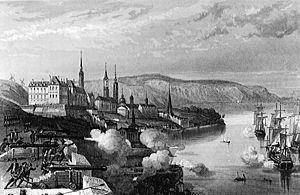
Two major attacks followed. One, led by Connecticut general Fitz-John Winthrop, targeted Montreal. The other, led by Sir William Phips, targeted Quebec. Winthrop's attack failed because of disease and supply problems. Phips was defeated in the Battle of Quebec. The Quebec and Port Royal attacks were the only big English attacks in King William's War. For the rest of the war, the English colonists mostly defended themselves, fought small battles, and made revenge raids.
The Iroquois Five Nations suffered because their English allies were weak. In 1693 and 1696, the French and their Native American allies destroyed Iroquois towns and crops. The New York colonists did nothing to help. After the English and French made peace in 1697, the Iroquois were left alone by the English. They continued to fight New France until 1701. Then, a peace agreement was made in Montreal between New France and many Iroquois and other tribes. This was called the Great Peace of Montreal.
Fighting in Hudson Bay
The war also involved a fight over trade in Arctic North America. The Hudson's Bay Company had built trading posts in James Bay and southern Hudson Bay in the early 1680s. French raiders, mainly led by Pierre Le Moyne d'Iberville, attacked these posts. They started with the Hudson Bay expedition and continued through the Nine Years' War. Most of these posts, including Moose Factory, York Factory, and Fort Albany, were taken by the French.
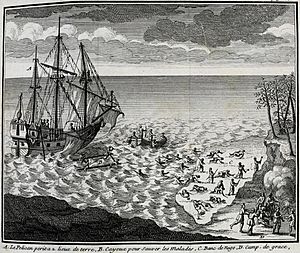
However, the French forces were small, and they did not hold onto the captured posts very strongly. York Factory was taken back by the English in 1695. In 1697, in the Battle of Hudson's Bay, one of the war's biggest naval battles, d'Iberville, with only one ship, defeated three English ships. He then went on to capture York Factory again.
What Happened After the War?
The Treaty of Ryswick, signed in September 1697, ended the war between France and England. It returned the colonial borders to how they were before the war. But the peace did not last long. Within five years, the colonies were fighting again in Queen Anne's War.
After their peace with France in 1701, the Iroquois stayed neutral in Queen Anne's War. They did not fight either side. Tensions remained high between the English and the tribes of the Wabanaki Confederacy. These tribes fought with the French again in Queen Anne's War. There were frequent raids in Massachusetts, including one on Groton in 1694 where children were kidnapped. Another was the Deerfield Massacre in 1704, where over 100 people were taken north to Montreal for ransom or adoption by Mohawk and French families. By the end of the war, Native Americans had killed over 700 English settlers and captured over 250 along the Acadia/New England border.
The Hudson's Bay Company was not happy with the Ryswick treaty. Most of its trading posts in Hudson Bay had been lost to the French before the war. So, the rule of "status quo ante bellum" (things return to how they were before the war) meant they stayed under French control. The company got its territories back later when the Treaty of Utrecht ended Queen Anne's War.
See also
 In Spanish: Guerra del rey Guillermo para niños
In Spanish: Guerra del rey Guillermo para niños


